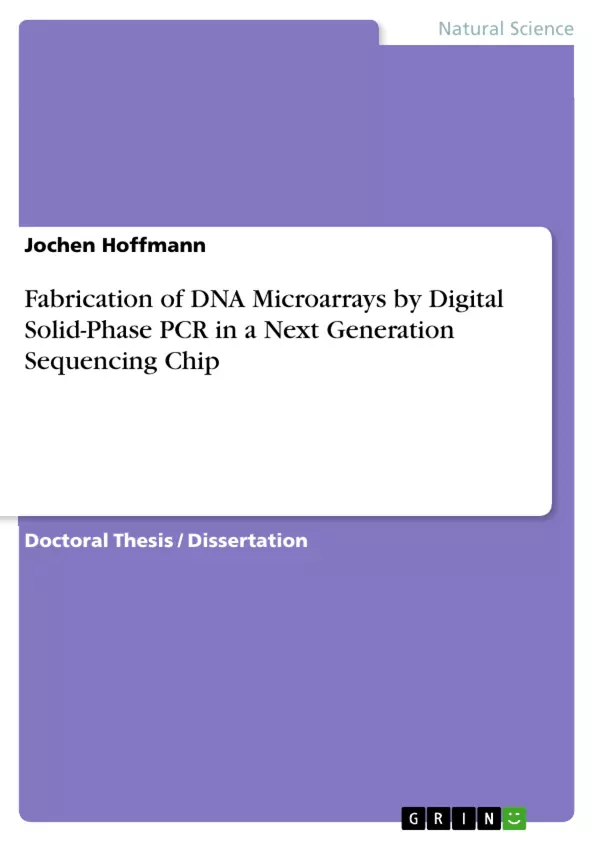A process for the fabrication of DNA microarrays by copying a next-generation sequencing chip is presented in this thesis. DNA molecules of a DNA library are mixed with a biochemical reaction mix and loaded into hundreds of thousands wells of the commercial sequencing chip PicoTiterPlate (PTP, Roche). The DNA randomly distributes onto the wells so that statistically one well contains one single DNA molecule. All wells of the PTP are closed with a microscope slide and the DNA is amplified by polymerase chain reaction (PCR). Each single PCR product is attached as a DNA cluster in the PTP and on the corresponding position on the slide since both surfaces have been coated with PCR primers. The sequence of each DNA cluster can be obtained by a subsequent sequencing reaction in the PTP. This also reveals the sequences of each DNA cluster on the slide thus allowing the slide to be used as a standard DNA microarray.
Inhaltsverzeichnis (Table of Contents)
- Abstract
- 1. Introduction
- 2. State of the Art
- 3. Materials and Methods
- 3.1. DNA Microarray Fabrication
- 3.2. Immobilization of PCR Primers onto Microscope Slides
- 3.3. Solid-Phase PCR (SP-PCR) on Microscope Slides
- 3.4. On-Chip PCR
- 3.5. Digital Solid-Phase PCR (dSP-PCR) in a PicoTiterPlate (PTP)
- 3.6. DNA Microarray Replication
- 4. Results and Discussion
- 4.1. Immobilization of PCR Primers onto Microscope Slides
- 4.2. Solid-Phase PCR (SP-PCR) on Microscope Slides
- 4.3. On-Chip PCR
- 4.4. Digital Solid-Phase PCR (dSP-PCR) in a PicoTiterPlate (PTP)
- 4.5. DNA Microarray Replication
- 5. Conclusion
- 6. Outlook
- References
Zielsetzung und Themenschwerpunkte (Objectives and Key Themes)
This dissertation presents a novel process for the fabrication of DNA microarrays using a next-generation sequencing chip. The main objective is to develop a method for replicating DNA microarrays from a master microarray generated by digital solid-phase PCR in a PicoTiterPlate (PTP).
- Immobilization of PCR primers onto various materials
- Solid-phase PCR (SP-PCR) on different substrates
- Digital solid-phase PCR (dSP-PCR) in a PTP
- DNA microarray replication
- Minimizing carry-over DNA contamination in dSP-PCR
Zusammenfassung der Kapitel (Chapter Summaries)
- Chapter 1: Introduction This chapter introduces the concept of DNA microarrays and their applications. It discusses the limitations of traditional DNA microarray fabrication methods and highlights the potential of using next-generation sequencing chips for this purpose.
- Chapter 2: State of the Art This chapter provides a comprehensive overview of the existing technologies for DNA microarray fabrication, including the use of solid-phase PCR and digital PCR. It also reviews the different methods for immobilizing PCR primers onto surfaces.
- Chapter 3: Materials and Methods This chapter details the materials and methods used in the dissertation. It describes the fabrication process of DNA microarrays using a PicoTiterPlate (PTP) and the different steps involved, including primer immobilization, solid-phase PCR, and DNA microarray replication.
- Chapter 4: Results and Discussion This chapter presents the results of the experiments conducted in the dissertation. It analyzes the efficiency of different methods for primer immobilization, solid-phase PCR, and digital solid-phase PCR. It also discusses the challenges and solutions related to carry-over DNA contamination in dSP-PCR.
Schlüsselwörter (Keywords)
DNA microarrays, next-generation sequencing, solid-phase PCR, digital PCR, PicoTiterPlate (PTP), primer immobilization, DNA replication, carry-over DNA, microfluidic devices, biofabrication.
- Quote paper
- Dipl.- Ing. Jochen Hoffmann (Author), 2013, Fabrication of DNA Microarrays by Digital Solid-Phase PCR in a Next Generation Sequencing Chip, Munich, GRIN Verlag, https://www.grin.com/document/300928



